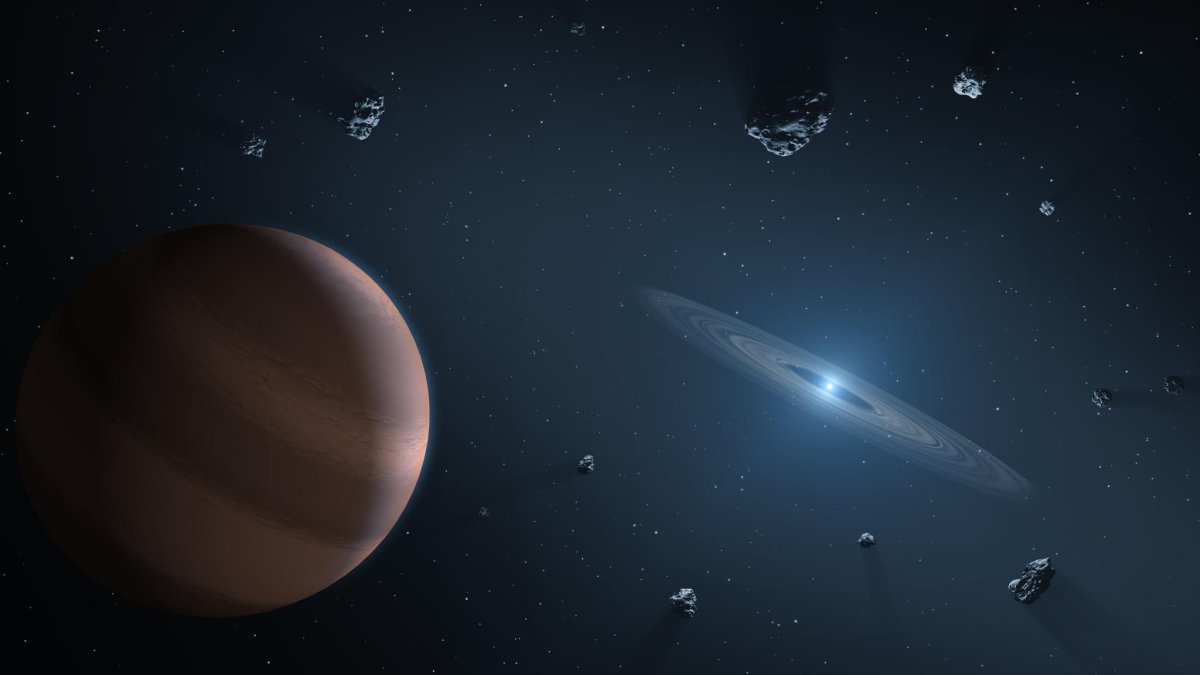We might think our planet is unique, but Earth's ingredients are uncannily similar to those found in planetary systems up to 465 light-years away, according to research.
Using some of the world's most powerful telescopes, scientists measured the compositions of 18 different planetary systems and compared them to our own. They found that the many elements in these systems are present in similar proportions to the distribution of materials seen on Earth.
The research, which was presented at the Goldschmidt geochemistry conference in Boston, is one of the largest investigations into the composition of materials in planetary systems beyond our own. The findings could both broaden our understanding of planetary formation and help us find Earth-like worlds.
"The chemical composition of Earth looks pretty normal. There are a few exceptions but most extrasolar rocky material looks like Earth," Siyi Xu of the Gemini Observatory in Hawaii, who led the research, told Newsweek. "Whatever conditions Earth was formed in, it is pretty common in other planetary systems as well. So there is hope to find Earth-like planets outside the solar system."
Examining these remote planets directly is very challenging due to the vast distances involved and the fact that nearby stars tend to drown out any electromagnetic signals, such as light or radio waves.
So instead, the scientists looked towards a class of stars known as white dwarfs to help them work out the composition of the planets. White dwarfs are the small, dense remnants of stars that have burnt off most of their hydrogen and helium fuel.
The researchers used instruments known as spectrographs on the Keck telescope in Hawaii—the world's largest optical and infrared telescope—and the Hubble Space Telescope to analyze electromagnetic signals coming from the white dwarfs. Spectrographs spread white light into its component colors, a spectrum in which the chemical "fingerprints" of different materials can be identified.
"White dwarfs' atmospheres are composed of either hydrogen or helium, which give out a pretty clear and clean spectroscopic signal," Xu said. "However, as the star cools, it begins to pull in material from the planets, asteroids, comets and so on which had been orbiting it, with some forming a dust disk, a little like the rings of Saturn."
"As this material approaches the star, it changes how we see the star," she said. "This change is measurable because it influences the star's spectroscopic signal and allows us to identify the type and even the quantity of material surrounding the white dwarf."
Among the elements found in the disks surrounding the white dwarfs include calcium, magnesium, silicon and perhaps even water in one of the systems, although the team has not quantified this yet.
"It's likely that there will be a lot of water in some of these worlds," Xu said. "For example, we've previously identified one star system, 170 light-years away in the constellation Boötes, which was rich in carbon, nitrogen and water, giving a composition similar to that of Halley's Comet."

The current research is still ongoing, according to Xu, who hopes to be able to determine the chemical compositions of planetary material outside our solar system to a much higher precision.
"It's astonishing to me that the best way to study exoplanet interiors is by planets ripped apart and absorbed by their white dwarf host star," said Sara Seager, professor of planetary science at Massachusetts Institute of Technology, who was not involved in the research. "It is great to see progress in this research area and to have solid evidence that planets with Earth-like compositions are common—fueling our confidence that an Earth-like planet around a very nearby normal star is out there waiting to be found".
Uncommon Knowledge
Newsweek is committed to challenging conventional wisdom and finding connections in the search for common ground.
Newsweek is committed to challenging conventional wisdom and finding connections in the search for common ground.
About the writer
Aristos is a Newsweek science reporter with the London, U.K., bureau. He reports on science and health topics, including; animal, ... Read more
To read how Newsweek uses AI as a newsroom tool, Click here.








